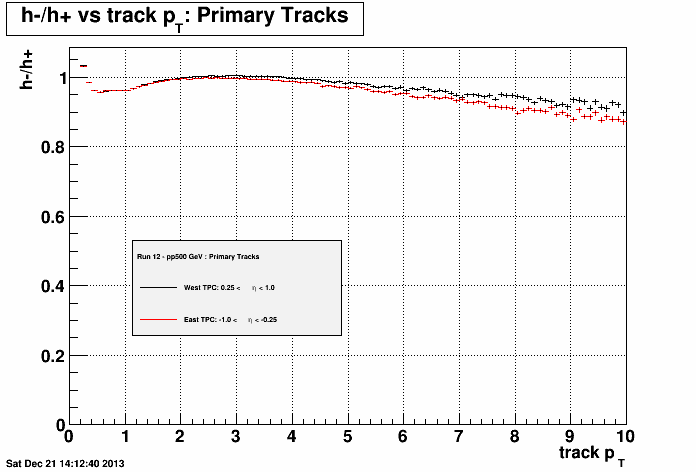- sra233's home page
- Posts
- 2019
- January (1)
- 2018
- 2017
- December (4)
- November (1)
- October (1)
- August (1)
- July (1)
- June (1)
- May (2)
- March (1)
- February (3)
- January (4)
- 2016
- 2015
- December (2)
- November (2)
- October (1)
- September (2)
- July (1)
- June (2)
- May (2)
- April (4)
- March (4)
- February (5)
- January (4)
- 2014
- December (3)
- November (3)
- October (3)
- September (2)
- August (1)
- July (3)
- June (1)
- May (3)
- March (1)
- February (5)
- January (2)
- 2013
- 2012
- My blog
- Post new blog entry
- All blogs
h-/h+ study - Run 2012 - pp500 GeV
Introduction:
The h-/h+ ratio is defined as the number of negative tracks divided by the number of positive tracks, in the TPC. In an ideal situation, this ratio is expected to be the same for both the West (0.0 < eta < 1.0) and East (-1.0 < eta < 0.0) sides of the TPC.
Event and Track Selection:
Events in Run 2012 (production - P13ib) that fire any of the the JP0, JP1, JP2, AJP, L2JetHigh or the VPDMB triggers are selected. Also, the tracks are required to be associated with the highest positve rank vertex. Tracks with nHits >12, nHits/nHistPoss > 0.51 and track pT > 0.2GeV are selected. (The 'good' RunList from Zilong, which had a total of 364 runs, was used for this study.)
Results:
The h-/h+ ratio for the global tracks in Run 12 pp500 GeV :
Figure 1

A clear seperation across all track pT can be seen from figure 1. Now we look into the h-/h+distribution for the primary tracks, in figure 2:
Figure 2

Conclusion:
The h-/h+ ratio problem, is clearly evident in the (total) Run 2012 pp500 GeV data, when we look at the global tracks. It looks much more consistent for the primary tracks.
Grant Webb did the h-/h+ study for Run 9 and Run 11. The details can be found at
https://drupal.star.bnl.gov/STAR/blog/gdwebb/2011/dec/08/h-h-pp500-rff-data-run-9-and-run-11
His plots show that the separation of primary tracks was much worse for 2009 than for 2011. For Run 12, the primary tracks look about as
good as Run 11. They aren't perfect, because there is still some separation at high pT, but still pretty good.
Details of the h-/h+ study for Run 2012-pp200 GeV can be found at
https://drupal.star.bnl.gov/STAR/blog/sra233/2013/dec/21/h-h-study-run-2012-pp200-gev
- sra233's blog
- Login or register to post comments
